|
Click any typewriter
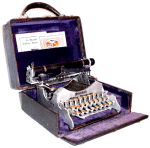
Standard Folding
1908
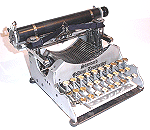
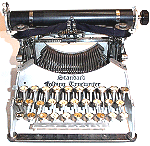
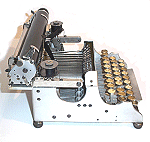

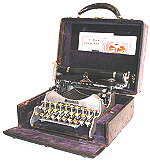



|
The
first commercially successful portable typewriter was patented in 1904 by
New York inventor Frank Rose. His machine, seen left, went into production
in 1907 as the Standard Folding Typewriter and the first machines came off
the production line in a cramped New York City loft in March 1908. The secret of the
machine's light weight and compact size was a combination of aluminium
construction and a unique folding mechanism that halved its size when
folded away. The little machine was an instant success and four
years later was succeed by a design that has passed into legend as one of the
most successful of all typewriters, the Corona 3. It also laid the foundations
for one of the most successful of all typewriter companies, Smith-Corona. Tragically, though he invented the first commercially successful portable typewriter
Frank Rose
died before it went into production. His son, George, raised
$150,000 on Wall Street with his father's patent and launched a new company to
manufacture it in 1907, The Rose Typewriter Company.
| To read the
remarkable story of the early struggle to form the Rose Typewriter Company
Click
Here. |
 |
| To read how Frank Rose's lost prototype of
the Folding Typewriter was recently rediscovered Click Here. |
 |
The Standard Folding Typewriter
 From March 1908 to
February 1912 close to 12,000 Standard Folding Typewriters were manufactured
(see bottom of page). Each machine came in a leatherette case at a standard price
of $50 -- a price that remained unchanged for decades. For an extra $3,
you could buy a slightly more luxurious real leather case, lined with velvet,
like the one shown here. The first 5,570 models made had the Cap key at one
side and the Fig key at the other as in the prototype. In July 1910, a slightly different
model was introduced with both keys at the left as in this machine, which was most likely manufactured some time in late 1910 or early 1911.
This particular machine has a keyboard with a French layout (Azerty instead
of Qwerty) showing that the company was manufacturing for export markets
even in its earliest years and even though it could scarcely satisfy demand in
the home
market. From March 1908 to
February 1912 close to 12,000 Standard Folding Typewriters were manufactured
(see bottom of page). Each machine came in a leatherette case at a standard price
of $50 -- a price that remained unchanged for decades. For an extra $3,
you could buy a slightly more luxurious real leather case, lined with velvet,
like the one shown here. The first 5,570 models made had the Cap key at one
side and the Fig key at the other as in the prototype. In July 1910, a slightly different
model was introduced with both keys at the left as in this machine, which was most likely manufactured some time in late 1910 or early 1911.
This particular machine has a keyboard with a French layout (Azerty instead
of Qwerty) showing that the company was manufacturing for export markets
even in its earliest years and even though it could scarcely satisfy demand in
the home
market.  Early U.S. made machines were sold in England, France and
Germany where they were re-branded as "Piccola" and "Azed".
Although it weighs only five and a half pounds and can
be held in one hand, the machine provides all the features of contemporary desk
machines, such as two-colour ribbon, margin release, multiple line spacing, and
shift-key locking. Two features it did not provide, however, were a back space
key and automatic ribbon reversal. When the typist reached the end of the
ribbon, he or she had to loosen the keeper nut on top of the full spool and
tighten the nut on the empty one! To conserve weight, every major component of the machine
was made from aluminium apart from the typebars, ribbon spools and the folding
arms themselves, which were made from steel for strength.
Unlike every
other typewriter on the market which were invariably painted black, the machines
remained unpainted. If you are using an expensive and rare material, as
aluminium then was, you
want everyone to know about it! Customers who wanted to buy a
portable typewriter in 1910, could kit themselves out with a Standard Folding
complete with leatherette case for $50. For the well to do typist, Early U.S. made machines were sold in England, France and
Germany where they were re-branded as "Piccola" and "Azed".
Although it weighs only five and a half pounds and can
be held in one hand, the machine provides all the features of contemporary desk
machines, such as two-colour ribbon, margin release, multiple line spacing, and
shift-key locking. Two features it did not provide, however, were a back space
key and automatic ribbon reversal. When the typist reached the end of the
ribbon, he or she had to loosen the keeper nut on top of the full spool and
tighten the nut on the empty one! To conserve weight, every major component of the machine
was made from aluminium apart from the typebars, ribbon spools and the folding
arms themselves, which were made from steel for strength.
Unlike every
other typewriter on the market which were invariably painted black, the machines
remained unpainted. If you are using an expensive and rare material, as
aluminium then was, you
want everyone to know about it! Customers who wanted to buy a
portable typewriter in 1910, could kit themselves out with a Standard Folding
complete with leatherette case for $50. For the well to do typist, 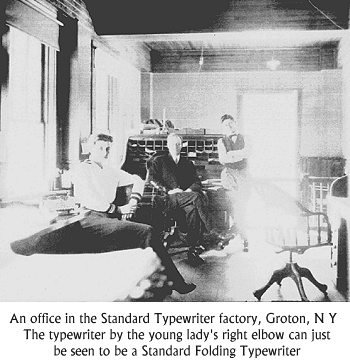 the machine
was available in a leather case for $55 or a Sole-Leather case for $58.
Accessories were available too. A black ribbon, on spool, cost $0.40 while a
two-colour ribbon was a little more at $0.50. Extra leatherette travel cases
could be bought for $3 and leather cases for $5. Special typewriter oil was
available at $0.20 and type brushes for $0.15. The most important and
most striking feature of the Standard Folding was, of course, the fact that the
carriage had been designed to detach completely from the key board and to fold neatly away when not in use. That Frank Rose
was able to separate the two precision mechanisms and bring them together again
and make them work together was a remarkable piece of engineering design from a
man who seems to have been mainly self taught. the machine
was available in a leather case for $55 or a Sole-Leather case for $58.
Accessories were available too. A black ribbon, on spool, cost $0.40 while a
two-colour ribbon was a little more at $0.50. Extra leatherette travel cases
could be bought for $3 and leather cases for $5. Special typewriter oil was
available at $0.20 and type brushes for $0.15. The most important and
most striking feature of the Standard Folding was, of course, the fact that the
carriage had been designed to detach completely from the key board and to fold neatly away when not in use. That Frank Rose
was able to separate the two precision mechanisms and bring them together again
and make them work together was a remarkable piece of engineering design from a
man who seems to have been mainly self taught.
Standard Folding Typerwriter production figures (based on serial
numbers) can be estimated to have been around 800 machines in 1908,
rising to around 2,200 in 1909, rising again to 4,500 machines in 1910
and around 4,500 again from the beginning of 1911 to February 1912, when the
Corona 3 was introduced, giving total production of around 12,000
machines. The earliest Corona 3 serial number so far found is 12,172.
To discover how the
Standard Folding Typewriter
was marketed in America and Europe from 1908
to
1912, follow this link.
|
